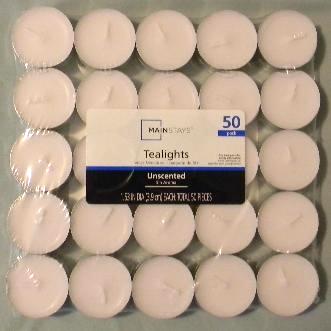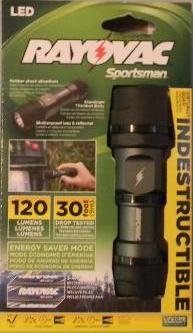
















Candles
Copyright © June 1, 2011 and February 11, 2014 by Robert Wayne Atkins, P.E.
All Rights Reserved.
The following information has been summarized from two different articles on my web site that discuss the use of candles in specific situations.
Introduction
Let me begin by saying that everyone should have a few candles in the event of an emergency. I have about two dozen short round candles and about 100 tea candles for an emergency.
However, I do not have a huge inventory of candles because I do not intend to use candles for light or for heating canned food. The candles are simply my "backup" plan in the event my primary plan doesn't work for some totally unexpected reason.
A candle has the following disadvantages:
- A candle is a fire hazard and it is estimated that candles account for between 6% to 10% of all house fires.
- A candle needs to be lit with a match or a butane lighter or some other source of a flame.
- A candle provides a very weak source of light.
- A candle should not be used for reading.
- A candle consumes oxygen and this can become a health risk in a small living area.
- A candle generates soot and the inhalation of soot causes health problems.
- A burning candle can be smelled from a reasonable distance away and this might lead someone to your place of refuge.
- When a candle has been used up it is gone and it must be replaced with another candle. In other words, a candle is not a renewable resource.
- A reasonable supply of candles would take up space and add weight to an emergency backpack or bug-out-bag.
- If you only need light for a few minutes then you will need to light the candle with a match or butane lighter, and then extinguish the candle when you no longer need the light to conserve the candle. Each time you light the candle you will need a match or you will be consuming butane lighter fuel. This may not be the best long-term use of your matches or butane lighters.
Some general information about candles:
- A candle should be burned above a heat-resistant surface.
- The flame of a candle can be used to heat a little water or a small amount food or it can be used to keep your hands warm. But a candle flame will not cook food.
- The flame of a candle should be protected from drafts to get the maximum life from the candle.
- The color of a candle does not impact its life expectancy.
- Do not invest in scented candles. You will probably get tired of the smell. And the odor may not be healthy over a long period of time.
- Before lighting a candle for the first time, trim the exposed wick to a length of 1/4 inch to prevent the loss of candle wax when the candle is first lit. A long wick will consume more wax until the wick can gradually burn down to its optimal length.
Data of Five Different Types of Candles
| Type of Candle | Diameter | Height | Cubic Inches | Ounces | Cost Each | Burn Time | Cost per Hour |
| Long or Tapered | 0.875 Inch | 8 Inches | 4.510 cu. in. | 2.50 oz. | $0.75 | 10.5 Hours | $0.071 per Hour |
| Plumber's Candle | 1.25 Inches | 5 Inches | 6.136 cu. in. | 3.30 oz. | $0.75 | 9 Hours | $0.083 per Hour |
| Short Round (Votive) | 1.375 Inches | 1.875 Inches | 2.784 cu. in. | 1.50 oz. | $0.97 | 12.25 Hours | $0.079 per Hour |
| Tea Candle (Tealight) | 1.50 Inches | 0.45 Inch | 0.795 cu. in. | 0.40 oz. | $0.05 | 4.25 Hours | $0.012 per Hour |
| 100 Hour Candle | 3.00 Inches | 4.5 Inches | 31.8 cu. in. | 12.2 oz. | $5.00 | 110 Hours | $0.045 per Hour |
Some comments about the above five types of candles:

- Long or Tapered Candle: This candle is usually placed in a candle holder or candlestick. As the candle burns it is constantly surrounded by fresh air and the molten wax runs down the side of the candle onto the candlestick. This wax is normally thrown away. However, during hard times you should consider how to safely collect this wax so it will continue to feed the wick as the candle burns down.
- Plumber's Candle: This candle is usually placed in a special candle holder with a wide opening for the bottom of the candle. As the candle burns it is constantly surrounded by fresh air and the molten wax runs down the side of the candle onto the candle holder. This wax is normally thrown away. However, during hard times you should consider how to safely collect this wax so it will continue to feed the wick as the candle burns down. A plumber's candle is essentially the same thing as a tapered candle except it is not tapered, and it is shorter, and it has a bigger diameter.
- Short Round (Votive) Candle: This candle is usually placed inside a glass candle holder that completely surrounds the candle and it extends about an inch above the top of the candle. The candle holder protects the candle flame from normal gentle drafts. As the candle burns the wax collects in the bottom of the glass candle holder and the wax is not lost because it continues to feed the wick until all the wax has been consumed. At the current time a glass candle holder for a Votive candle costs about $2.00 each.
- Tea Candle or Tealight: This candle is sold inside a self-contained soft foil container. The foil container completely surrounds the wax. As the candle burns the molten wax is trapped inside the foil container and the wax feeds the wick until all of the wax has been consumed. A tea candle is a very efficient candle because it has its own foil container and it completely consumes all of its wax. At the current time a small glass candle holder for a tea candle costs about $0.75 and one of these glass candle holders should be used to keep the tea candle safely contained while it is burning and to protect the surface on which the candle rests. At the current time tea candles can be purchased for approximately $2.25 for a package that contains 50 unscented tea candles. Every family should have a supply of tea candles, and five or six glass candle holders specifically designed for tea candles. Tea candles could serve as a backup source of light if your LED flashlight or lantern does not work for some reason.
- 100 Hour Candle: This is basically a single-use oil lamp. Liquid paraffin is contained inside a clear plastic bottle with a wick extending down into the bottle. As the wick is consumed you must occasionally blow the wick out and wait for it to cool. Then you use some needle nose pliers to gently twist and turn and pull the wick up until about 1/4 inch of the wick is above the top of the container. Then you can relight the wick. This candle is odorless and smokeless.
Flashlights: A Practical Alternative to a Candle
 A flashlight has the following advantages:
A flashlight has the following advantages:
- A flashlight does not consume oxygen or emit any type of odor.
- A flashlight provides a strong source of light that can be focused into the distance or it can be used to light an entire room.
- A flashlight may be used to provide light to read comfortably.
- A L.E.D. flashlight bulb will last for approximately 100,000 hours so it will not need to be replaced during your lifetime. A L.E.D. flashlight bulb consumes less power than an ordinary flashlight bulb.
- A flashlight will work using rechargeable batteries. You can recharge batteries using the sun. Therefore, a flashlight, plus some rechargeable batteries, plus a solar battery charger, is a renewable resource that will last for many, many years.
- The above items would not take up much space in your emergency backpack or bug-out-bag.
More information about flashlights is here.
The sun is a source of renewable energy. If you had a solar panel and a 12-volt deep-cycle marine battery or a golf cart battery, then you could capture and store the sun's energy inside your 12-volt battery. You could then tap that battery whenever you needed power. For example, you could recharge your portable computer, or your cell phone, or your AA batteries that you use in your radio or flashlight. If you also had a 1,200 watt inverter then you could run 110-volt electrical appliances for very short periods of time, such as an electric drill, or a printer, or a small microwave oven. This means you could briefly heat some canned food to a reasonable temperature inside a small microwave oven using the sun's energy you previously stored inside a 12-volt deep-cycle battery. Solar power is such a practical option that every family should have their own solar generator.
Respectfully,
Grandpappy.
Grandpappy's e-mail address is: RobertWayneAtkins@hotmail.com





































 A flashlight has the following advantages:
A flashlight has the following advantages:
